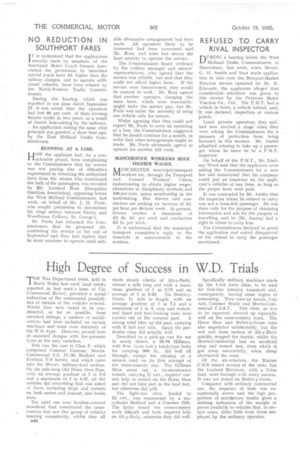High Degree of Success in W.D. Trials
Page 58

If you've noticed an error in this article please click here to report it so we can fix it.
THE War Department trials, held in North Wales last week (and briefly reported in last week's issue of The Commercial Motor), provided a useful indication of the commercial possibilities of certain of the vehicles entered. Whilst they were stated to be constructed, so far as possible, from standard fittings, a number of modifications had been included on certain machines and some were definitely of the W.D.-type. However, several were of standard designs with low-pressure tyres as the only variation.
This was the case in Class F, which comprised Commer Centaur, MorrisCommercial S.S. 11/30, Bedford and Fordson V-8 lorries, and which came into the 30-cwt. military-load section. On the mile-long Old Horse Shoe Pass, with an average gradient of 1 in' 7.6 and a maximum of 1 in 4.87, all the vehicles did everything that was asked of them, including stops and restarts on both ascent and descent, also brake tests.
The brief run over heather-covered moorland that constituted the crosscountry test saw this group of vehicles running . consistently, whilst they all s44 made steady climbs of Alt-y-Bady. almost a mile long and with a maximum gradient of 1 in 3.38 and an
average of 1 in 6.69. On 13w1ch-yGroes, 11 mile in length, with an average gradient of 1 in 7.1 and a maximum of 1 in 4, stop and restart, and hand and foot-braking tests were carried out at the steepest part. A strong wind blew up the pass, carrying with it hail and rain. Again the particular class did notably, well.
Described as a Pick-up van for use in sandy desert, a 20-70 Hillman, with 9-in. tyres and a truck-type body for carrying 900 lb., did well all through, except for sticking at a sunken road on its first attempt of the cross-country run. The Hillman Minx scout car, a reconnaissance vehicle, carrying 11; cwt., required outside help to restart on the Horse Shoe and did not take part in the final test, but othenvise did well.
The light-van class, loaded to 12 cwt,, was represented by a sixcylinder Bedford and a Commer B20. The latter found the cross-country work difficult and both required help on Altsy-Bady, otherwise they did well. Specifically military machines made up the 1-ton lorry class, to be used for first-line infantry transport and, consequently, having some degree of armouring. They were an Austin, Guy Ant, Commer Beetle and Morris-Com mercial C.S.8.T. This class, as was to be expected, showed up especially well on the cross-country work. The Horse Shoe and Bwlch-y-Groes were also negotiated satisfactorily, but the wet and loose surface of Alt-y-Bady quickly stopped the Austin, whilst the Morris-Commercial had an unofficial stop and restart test, from which it got away successfully, when sheep obstructed the road.
Of -the six-wheelers, the Karrier C.K.6 missed several of 'the tests, but the Leyland Retriever, with a 3-ton load, went through with every success. It was not tested on Bwlch-y-Groes.
Compared with ordinary commercial use, the sequence of tests was exceptionally severe and the high proportion of satisfactory results gives a striking indication of the margin of power available to vehicles that, in certain cases, differ little from those employed by the ordinary operator.




























































































